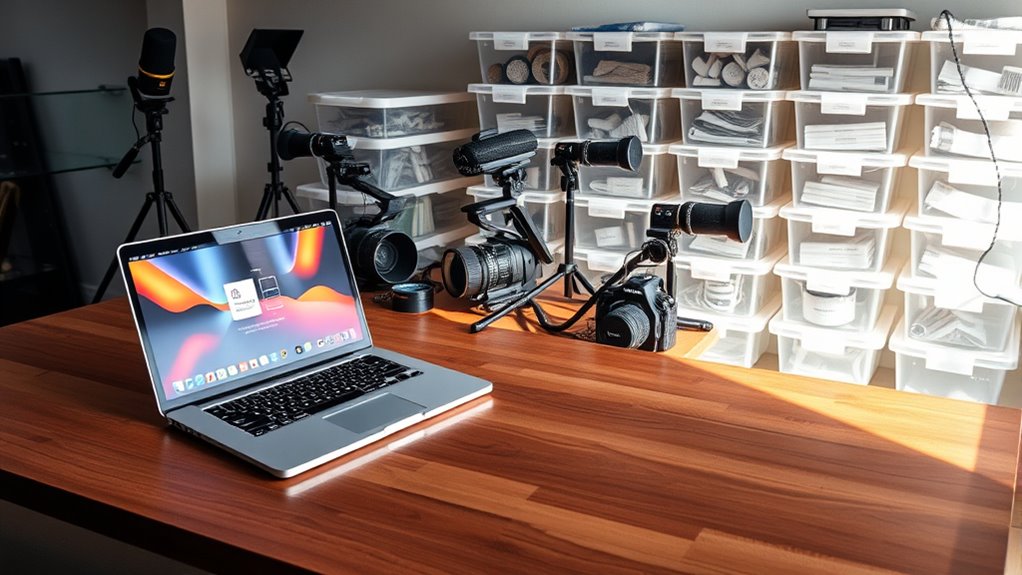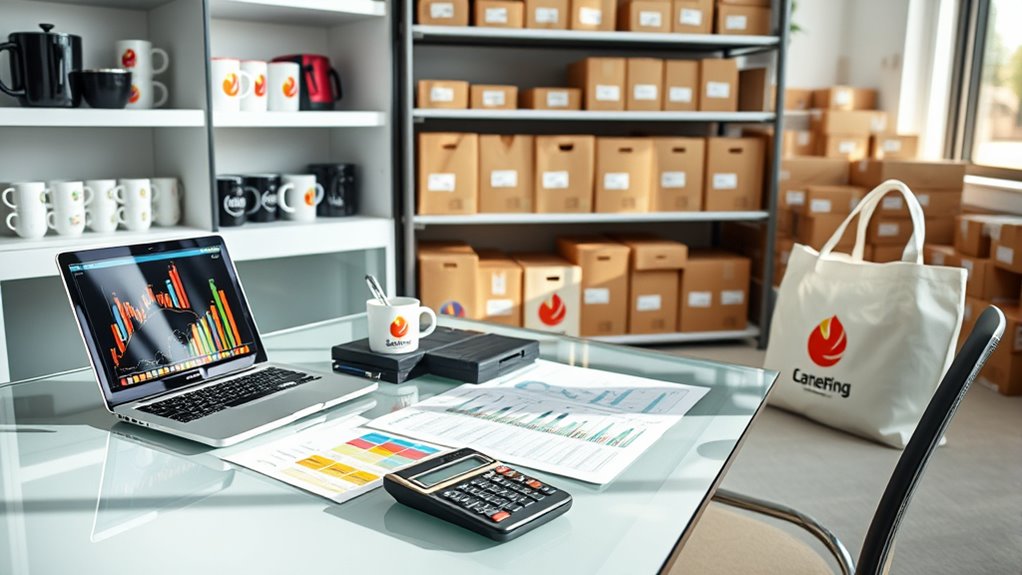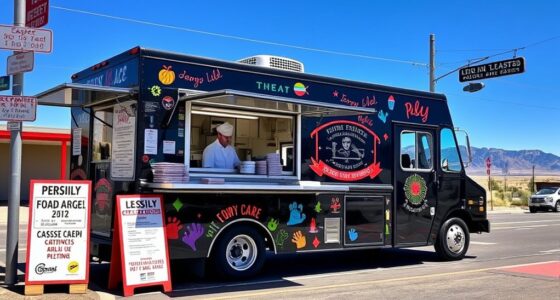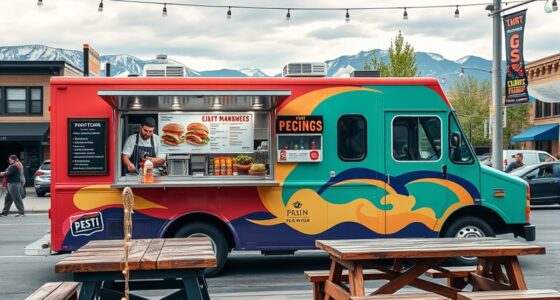To budget effectively for equipment, branding, and inventory, you should analyze your current costs and forecast future needs based on sales and market trends. Allocate funds carefully, balancing quality with cost-efficiency, and keep a contingency fund for unexpected expenses. Regularly review and adjust your budget as your business evolves to stay aligned with your financial goals. Continue exploring these strategies to optimize your business’s financial planning.
Key Takeaways
- Conduct a detailed cost analysis to estimate necessary expenses for equipment, branding, and inventory.
- Allocate a specific budget for each component based on priority and expected impact.
- Track expenditures regularly using spreadsheets or software to stay within planned budgets.
- Incorporate a contingency fund to manage unexpected costs or emergencies.
- Review and adjust the budget periodically to adapt to market changes and business growth.

Creating a solid budget for equipment, branding, and inventory is essential for ensuring your business runs smoothly and grows sustainably. Without a clear financial plan, you risk overspending or underfunding critical areas, which can hinder your progress. To start, you need to conduct a thorough cost analysis—this means evaluating what each component will genuinely cost and how it fits into your overall financial picture. Break down your expenses into categories: equipment purchases, branding efforts, and inventory costs. By doing this, you’ll identify the necessary investment versus optional spending, helping you prioritize what’s essential for your current stage and future growth.
Conduct a thorough cost analysis to prioritize essential investments for sustainable business growth.
Expense tracking plays a crucial role in keeping your budget on target. As you acquire equipment, launch branding campaigns, and purchase inventory, keep detailed records of every expenditure. Use spreadsheets, accounting software, or expense management tools to monitor your spending in real-time. This way, you’ll quickly spot any deviations from your plan and adjust accordingly. Regularly reviewing your expense tracking data allows you to make informed decisions about where to cut costs or reallocate funds to higher-priority projects.
When budgeting for equipment, focus on balancing quality and cost-efficiency. Consider whether leasing or buying makes more sense for your cash flow and long-term goals. For branding, allocate funds not only for design and advertising but also for consistent brand messaging across your channels. Remember, branding is an ongoing investment, so set aside a portion of your budget for future campaigns or updates. Inventory budgeting requires careful forecasting based on sales projections. Overstocking can tie up capital unnecessarily, while understocking risks missed sales. Use historical data and market trends to estimate your inventory needs accurately.
As you develop your budget, always build in a contingency fund for unexpected expenses. Equipment repairs, last-minute branding opportunities, or inventory shortages can arise unexpectedly, and having a financial cushion will prevent these issues from derailing your plans. Additionally, understanding the costs of supplies and materials associated with your inventory helps you make better purchasing decisions and avoid surprises. Revisit and adjust your budget regularly, especially as your business evolves or market conditions change. Staying flexible ensures you remain aligned with your financial goals and can capitalize on new opportunities.
Ultimately, a well-planned budget rooted in detailed cost analysis and diligent expense tracking provides a strong foundation for your business. It helps you allocate resources wisely, avoid unnecessary debt, and support your growth ambitions. By staying disciplined and proactive with your financial management, you’ll position your business for long-term success and stability.
Frequently Asked Questions
How Often Should I Review and Update My Budget?
You should review and update your budget monthly to stay on top of cash flow and guarantee accurate expense forecasting. Regularly checking allows you to identify any variances early and make adjustments as needed. If your business experiences seasonal fluctuations or significant changes, consider more frequent reviews. Staying proactive helps you maintain financial stability, control costs, and plan effectively for upcoming expenses.
What Are Common Unexpected Costs in Equipment Budgeting?
Unexpected equipment costs often include repairs, maintenance, and replacement parts that you didn’t plan for. You might also face budgeting surprises like price increases or shipping delays. To avoid surprises, set aside a contingency fund and regularly review your budget. This way, you’re prepared for unexpected equipment costs, ensuring your business stays on track financially without sudden setbacks.
How Do I Prioritize Branding Investments With Limited Funds?
You should prioritize branding investments by focusing on your branding strategy’s core elements that deliver the highest return. Allocate funds to cost-effective marketing channels like social media and content marketing, which can boost visibility without overspending. Consider your target audience’s preferences and where they engage most. By aligning your branding efforts with your strategic goals, you maximize impact even with limited funds, ensuring steady growth and brand recognition.
What Inventory Turnover Rate Is Ideal for Small Businesses?
You should aim for an inventory turnover rate of 4 to 6 times annually. This balance guarantees your inventory management stays efficient, preventing overstocking or stockouts. Keep sales forecasting in mind to adjust your turnover rate based on seasonal fluctuations and demand trends. A steady turnover helps maintain cash flow, reduces storage costs, and keeps your small business agile and responsive to customer needs.
How Can I Track ROI on Branding Expenses Effectively?
You can track ROI on branding expenses effectively by leveraging marketing analytics tools to measure changes in brand awareness and customer engagement over time. Focus on key metrics like website traffic, social media interactions, and brand surveys. Compare these insights against your branding spend to see what delivers the best return. Regularly analyze these data points to refine your branding strategies and guarantee your investments boost overall brand value.
Conclusion
Remember, a well-balanced budget acts as your silent partner, gently guiding your business toward growth. By thoughtfully allocating funds for equipment, branding, and inventory, you create a sturdy foundation that quietly supports your success. While it may seem like a small step, neglecting these areas can subtly hinder your progress. Embrace smart planning now, and watch your business flourish without unnecessary strain—sometimes, the quiet investments make the loudest impact.









